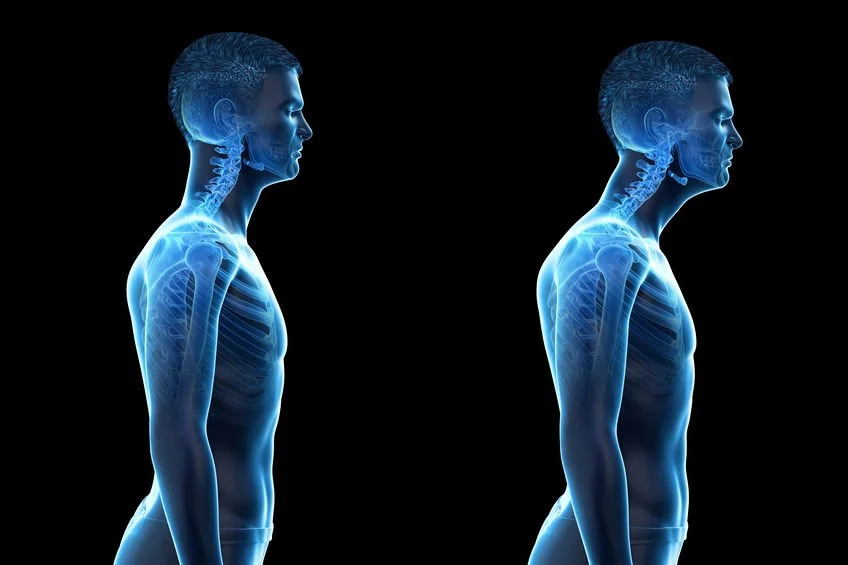Head forward posture, also known as forward head posture or anterior head carriage, is a common postural problem that occurs when the head is positioned too far forward in relation to the shoulders. It is often associated with a hunched or rounded upper back and can contribute to neck and shoulder pain.
There are several factors that can contribute to head forward posture, including:
Prolonged sitting or standing with poor posture, such as slouching or looking down at a computer or phone screen.
Weakness or tightness in the muscles of the neck, shoulders, and upper back, which can cause the head to move forward to compensate.
Imbalances in the muscles of the neck and upper back, such as overuse of the muscles on one side of the body or poor coordination between different muscle groups.
Injuries or conditions that affect the alignment of the spine, such as whiplash or scoliosis.
Age-related changes, such as decreased muscle strength and bone density, that can affect posture.
If left untreated, head forward posture can lead to chronic pain and discomfort. To address this issue, it is important to identify and address any underlying factors that may be contributing to the problem. This may involve working with a physical therapist, chiropractor, or other healthcare provider to develop a targeted exercise and stretching program to strengthen and lengthen the muscles of the neck, shoulders, and upper back, and to improve overall posture and alignment.
There are a variety of exercises and stretches that can help to correct head forward posture and improve overall posture and alignment. These exercises work to correct head forward posture by targeting the muscles that support the head, neck, and upper back, and by improving overall posture and alignment. Here are some ways in which these exercises can be effective:
Here are a few examples:
Chin tucks: Sit or stand up straight and slowly draw your chin back toward your neck, as if making a double chin. Hold for a few seconds, then release. Repeat for several reps.
This exercise helps to strengthen the deep neck flexors, which are the muscles that run along the front of the neck and help to stabilize the head and neck. By strengthening these muscles, the head is less likely to move forward and the neck is better able to support the weight of the head.
Shoulder blade squeezes: Sit or stand up straight and squeeze your shoulder blades together. Hold for a few seconds, then release. Repeat for several reps.
This exercise helps to strengthen the muscles between the shoulder blades, which are important for maintaining proper posture and alignment of the upper back. By strengthening these muscles, the shoulders are better able to support the weight of the arms and upper body, which can help to prevent head forward posture.
Neck Stretches: Gently tilt your head to the side, bringing your ear toward your shoulder, and hold for a few seconds. Repeat on the other side. You can also gently turn your head to the left and right, holding each position for a few seconds.
These stretches help to lengthen and release tension in the muscles of the neck, which can become tight and shortened due to head forward posture. By stretching these muscles, the head and neck are better able to move and maintain a neutral position.
Wall Angels: Stand with your back against a wall and slowly raise your arms to shoulder height, bending your elbows to touch your forearms to the wall. Slowly lower your arms back down, keeping your back and head against the wall.
This exercise helps to improve posture and alignment of the upper back by strengthening the muscles that retract and depress the shoulder blades. By improving the strength and coordination of these muscles, the upper back is better able to support the weight of the arms and upper body, which can help to prevent head forward posture.
Cat-cow stretch: Get on your hands and knees and alternate between arching your back up and rounding it down, moving your head with your spine.
This exercise helps to improve mobility and flexibility in the spine, which can become stiff and immobile due to poor posture. By gently moving the spine in different directions, the muscles of the neck, shoulders, and upper back are better able to support the weight of the head and upper body.
Chest stretch: Stand in a doorway with your arms at shoulder height and elbows bent to 90 degrees. Place your forearms on the sides of the doorway and gently lean forward to stretch your chest.
This stretch helps to lengthen and release tension in the muscles of the chest, which can become tight and shortened due to head forward posture. By stretching these muscles, the shoulders are better able to move back and down, which can help to prevent head forward posture.
By incorporating these exercises into a regular exercise and stretching program, it is possible to improve posture and alignment and prevent head forward posture from becoming a chronic problem.
Remember to breathe deeply and move slowly and mindfully as you perform these exercises. It's important to avoid any movements that cause pain or discomfort, and to work with a physical therapist or other healthcare provider if you have any underlying conditions that may affect your ability to perform these exercises safely.
